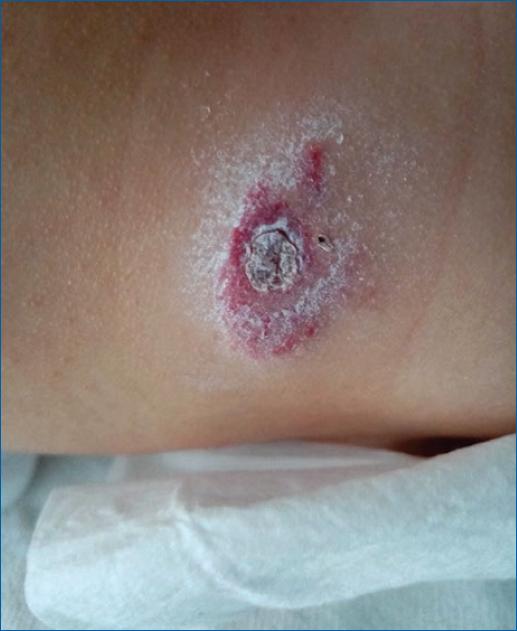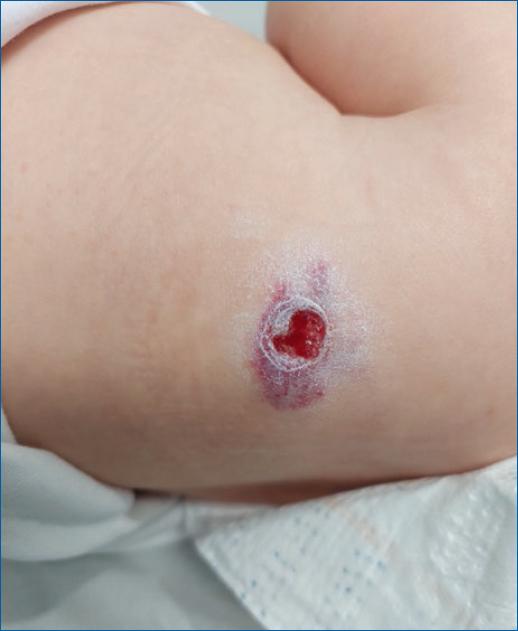To the Editor,
Oral propranolol has replaced corticosteroids as the gold standard therapy for infantile hemangiomas (IH)1-3. However, in some settings, such as ulceration, it might not be sufficient or even trigger or worsen ulceration2,4. Treatment of refractory ulceration with oral propranolol is not consensual but brief adjunct courses of combined therapy with oral corticosteroids seem to accelerate improvement and promote healing2,4.
A 2-month-old male, Caucasian with a previous history of preterm birth and low birth weight, was referred to a pediatric dermatology consultation due to a solitary superficial IH in the right flank. Topical timolol was used initially with good response and IH stabilization. However, at 6-month-old, rapid growth followed by central ulceration was noted, reaching, in the next month, a dimension of 4 per 3 cm with an ulcerative area of 1 cm. Despite being initiated at low doses (1 mg/kg daily), oral propranolol triggered ulceration worsening (Fig. 1). This led to add-up therapy with oral prednisolone (1.3 mg/kg daily) for 15 days (Fig. 2), followed by slow tapering doses for 15 additional days (total time of corticosteroids use 1 month), and concurrent slowly upward doses of propranolol. To facilitate ulceration healing, silicone and polyurethane pads were used (area of great friction by the diaper). Progressive healing of ulceration was noted with complete reepithelization after 2 months (1 month of combined treatment followed by 1 month of propranolol alone) when therapeutic propranolol doses were reached (2 mg/kg daily). Weaning from propranolol was started after 3 additional months.

Figure 2 Partial healing of ulceration after 2 weeks of combined therapy with propranolol and prednisolone at full dose (1.3 mg/kg daily).
Since the discovery of propranolol's beneficial effects for IH and its efficacy and improved safety profile compared to systemic corticosteroids were proven, a switch to β-blockers as first-line treatment for complicated IH occurred1-3. However, in some cases, such as IH with complex ulceration, propranolol in monotherapy might not be sufficient, and a brief course of oral corticosteroids might have an important adjunctive role2,4. Lie and Püttgen reported two cases in which a 5 and 2-week full dose of oral prednisolone (2 mg/kg daily) followed by slow tapering doses over 4 additional weeks were used effectively to control and promote ulcer healing in IH with moderately deep ulceration refractory to propranolol and local therapies alone. In both cases, oral propranolol alone enabled IH volume and overall size to improve rapidly, although with no response regarding ulceration, which only occurred after add-up therapy with prednisolone2. Meyer-Mueller et al. also described a case of a lip IH impairing feeding, in which progressive worsening of ulceration occurred despite oral propranolol doses up to 3 mg/kg daily. Adjunctive treatment with prednisolone (2 mg/kg daily) for 4 months enabled ulcer healing4. This effect was also seen in our case, in which add-up therapy with oral prednisolone led to ulceration control and progressive healing. The mechanism by which adding systemic corticosteroids to propranolol promotes rapid ulcer healing is not known and further studies are warranted2. There is no standard protocol on the dose and duration of oral corticosteroid use1,2,5, although 2-3 mg/kg daily has been shown to be effective, as seen in the previous reports. However, with multimodality treatment, lower corticosteroid doses are also likely to be effective2,5, as observed in our case. In neither case (reported previously in literature nor ours), recurrence of ulceration occurred after suspension of oral corticosteroids, and oral propranolol was maintained in monotherapy for additional months facilitating IH regression. Despite concerns regarding the dual use of these medications and hypoglycemia risk during corticosteroid weaning6,7, this complication was only reported once and was attributed to adrenal suppression due to prolonged use of high corticosteroid doses6. Regarding the additional use of corticosteroids as a combined treatment for IH, Aly et al. also studied the usage of oral propranolol alone versus combined with 2-week oral prednisolone “priming”, showing a statistically superior reduction in IH size, thus recommending its use for life or function-threatening IH8. Gnarra et al. also found in a case series of three patients with PHACE syndrome that the combination of low-dose propranolol and low-dose prednisolone showed a more rapid and sustained improvement of segmental hemangiomas than monotherapy7. Another important aspect highlighted by our case is that ulcerated IH might also benefit from lower and slowly titrated doses of propranolol, since propranolol might worsen ulceration1-4,9, due to the proposed mechanism of decreased tissue perfusion through vasoconstriction3,9. As such, doses ≤ 1 mg/kg daily should be considered as an initial approach to ulcerated IH, with slow upward titration ideally after healing is well under way3,9. In conclusion, we considered that oral corticosteroids might still play a valuable role in IH management, recommending its use as combined therapy if significant or painful ulceration persists after 2-4 weeks of treatment with oral propranolol.















